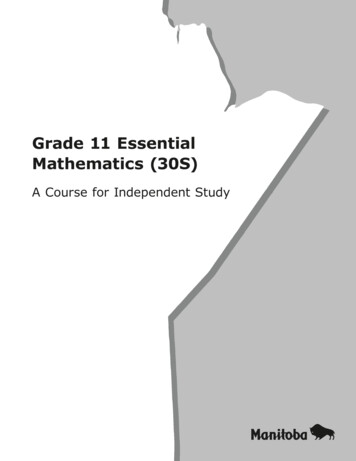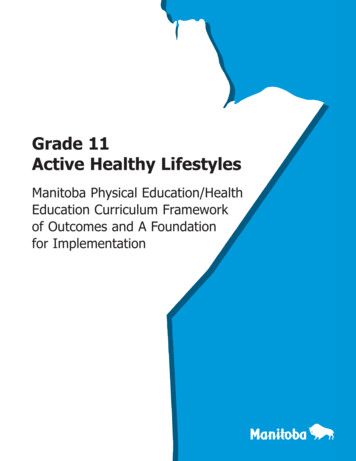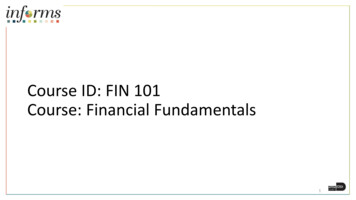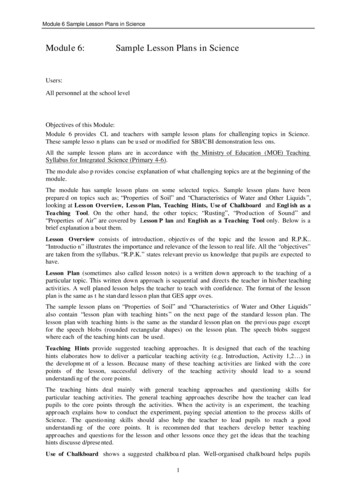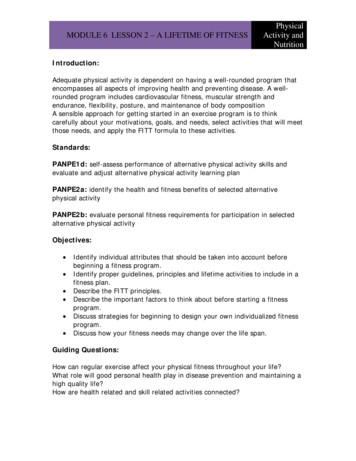
Transcription
MODULE 6 LESSON 2 – A LIFETIME OF FITNESSPhysicalActivity andNutritionIntroduction:Adequate physical activity is dependent on having a well-rounded program thatencompasses all aspects of improving health and preventing disease. A wellrounded program includes cardiovascular fitness, muscular strength andendurance, flexibility, posture, and maintenance of body compositionA sensible approach for getting started in an exercise program is to thinkcarefully about your motivations, goals, and needs, select activities that will meetthose needs, and apply the FITT formula to these activities.Standards:PANPE1d: self-assess performance of alternative physical activity skills andevaluate and adjust alternative physical activity learning planPANPE2a: identify the health and fitness benefits of selected alternativephysical activityPANPE2b: evaluate personal fitness requirements for participation in selectedalternative physical activityObjectives: Identify individual attributes that should be taken into account beforebeginning a fitness program.Identify proper guidelines, principles and lifetime activities to include in afitness plan.Describe the FITT principles.Describe the important factors to think about before starting a fitnessprogram.Discuss strategies for beginning to design your own individualized fitnessprogram.Discuss how your fitness needs may change over the life span.Guiding Questions:How can regular exercise affect your physical fitness throughout your life?What role will good personal health play in disease prevention and maintaining ahigh quality life?How are health related and skill related activities connected?
MODULE 6 LESSON 2 – A LIFETIME OF FITNESSPhysicalActivity andNutritionFitness Escapade PreludeRiding bikes; ShutterstockBefore you start a fitness program, consider the following factors: Do you have any special health constraints?Are you healthy enough to start a fitness program?What types of activities do you enjoy?How much of you activities are planned?
MODULE 6 LESSON 2 – A LIFETIME OF FITNESSPhysicalActivity andNutritionExplore Equipment OptionsChoice of equipment depends on your fitness goals, type of equipment availableto you, your experience and your preferences.Free WeightsPersonal trainers and exercise physiologists consider free-weight exercise to be amore advanced approach to resistance-training in part because it allows the bodyto move through its natural range of motion and promotes the use of posturaland stabilizing muscles. The exercises use dumbbells, weights intended for useby one hand as well as a variety of barbells, a long bar with weight plates oneach end.Lifting free weights; ShutterstockAlternate EquipmentResistance bands made of tubing or flat strips of rubber allow you to gainmuscular strength and endurance throughout a range of motion. Stability ballsare large vinyl balls on which you sit, lie down, or balance. They help you todevelop core trunk muscles. Medicine balls are heavily weighted and help youincrease resistance, whether used individually, with a partner, or in a group.Exercising on Pilates ball; Shutterstock
MODULE 6 LESSON 2 – A LIFETIME OF FITNESSPhysicalActivity andNutritionNo-Equipment TrainingCalisthenics can be performed without any equipment because they use yourown body weight to provide the resistance.Jumping jacks; ShutterstockTraditional TrainingProgram can include exercises on a combination of machines, exercises with freeweights, and calisthenics. All of these exercises typically include a set number ofrepetitions-the number of times a particular exercise is performed-and sets,which include a fixed number of repetitions, interspersed with rest periods.Lifting free weights; ShutterstockCircuit TrainingIn circuit weight training, you move from one station to another in a set pattern(the “circuit”). Some circuits include stations for aerobic exercises along with theresistance-training stations.Lifting weights; ShutterstockPlyometrics/Dynamic Sports TrainingAthletes may include plyometric exercises, which mimic the quick, percussivemovements needed in many sports. They are characterized by a rapiddeceleration of the body followed by a rapid acceleration in the oppositedirection. Power lifting is a type of resistance training in which an individual liftsa heavy weight quickly. It should be performed only by experienced athletes.Many athletes also include speed and agility drills, which improve muscleresponsiveness, speed, footwork, and coordination.
MODULE 6 LESSON 2 – A LIFETIME OF FITNESSPhysicalActivity andNutritionNeighborhood: Some research suggests that urban sprawl may be partly toblame for the current obesity epidemic. When exercising in your neighborhood,choose streets with sidewalks, bike lanes, walking trails, street lights, and lesstraffic.Running up the stairs; ShutterstockWeather: If you are prepared, you can exercise in most weather conditions.The key is to pay attention to your body and take the necessary safetyprecautions.Guy hiking in the mountains; ShutterstockExercise Facility Options: Choose a facility based on its location, classesoffered, equipment, cost, and any other amenities that is important to you.Don’t overlook the facilities offered at your installation!Gym; Shutterstock
MODULE 6 LESSON 2 – A LIFETIME OF FITNESSPhysicalActivity andNutritionSafety: To be safe, exercise with a friend or group, choose a neighborhood withless traffic, and wear reflective clothing. If you plan to hike or bike in awilderness area, let someone know where you are going and how long you planto be gone. Carry a cell phone, GPS, basic safety supplies, and food and waterfor a day. Bring any safety concerns at a fitness facility to the attention of themanager.Girls running in the country; ShutterstockThe Stairway to Lifetime Fitness: To make good decisions about lifetimephysical activity, you start at a level of dependence on others and develop a levelof decision making as you progress to a level of independence.Step 1 - Doing Physical Activity:Do activities that are planned by others, this makes getting started easier. Lookfor opportunities to participate in school activities, physical education classes,and community ventures.Group doing Pilates; ShutterstockStep 2 - Getting Fit:Learn to become responsible for your own physical fitness. Fitness is somethingthat was often planned for you when you were young, and coaches instructedactivities to get you fit for sports.
MODULE 6 LESSON 2 – A LIFETIME OF FITNESSPhysicalActivity andNutritionGroup riding stationary bikes; ShutterstockStep 3 - Self-Assessment:Before you can make good decisions about your own personal fitness andactivities, you need to know your own personal fitness levels. Assessing yourfitness levels allows for better fitness decision making & program planning.Guy stretching by waterfront; ShutterstockStep 4 - Self-Planning:Track your progress; use a weight-training log or a notebook. Use your ownfitness and activity results to help plan your own program. Each personal fitnessprofile will be different for each individual.List of goals; ShutterstockStep 5 - Lifetime Activity:When you learn why physical activity is important, you will be able to decidewhat your fitness level needs are, and how you can plan them for a lifetime.Riding bike at sunset; ShutterstockStep 6 - Lifetime Fitness:When you have taken responsibility for your own lifetime fitness needs, you havemoved away from dependence on others to keep you fit, to personalindependence.Cartwheel on the beach; Shutterstock
MODULE 6 LESSON 2 – A LIFETIME OF FITNESSPhysicalActivity andNutritionSummary:Maintaining good health and wellness habits can help extend your overall lifeexpectancy. That’s because sound health and wellness choices-such as wearing a seatbelt; avoiding smoking, drugs, and alcohol abuse; eating a healthy diet; and engaging inregular physical activity-reduce your risk of traumatic injury and chronic disease.Throughout your life, you will reevaluate your fitness needs and learn to adjust yourphysical activity program as needed to maintain an optimal fitness level. A sedentarylifestyle, in which a person exerts physical effort only for required daily tasks and not forleisure-time fitness activities, increases the risk of obesity, high blood pressure, andother diseases.Student Practice:What’s The Plan?In this activity, you will apply basic knowledge of resistance training.Instructions: Read the following and provide a written response of at least twoparagraphs.Scenario: A friend is planning to start a weight training program and asks foryour advice in getting started. She has no experience in lifting weights and is
MODULE 6 LESSON 2 – A LIFETIME OF FITNESSPhysicalActivity andNutritionnew to the fitness facility. What advice might you offer to ensure that she getsoff to a safe start?
MODULE 6 LESSON 2 – A LIFETIME OF FITNESS Physical Activity and Nutrition Introduction: Adequate physical activity is dependent on having a well -rounded program that encompasses all aspects of improving health and preventing disease. A well - rounded program includes cardi


